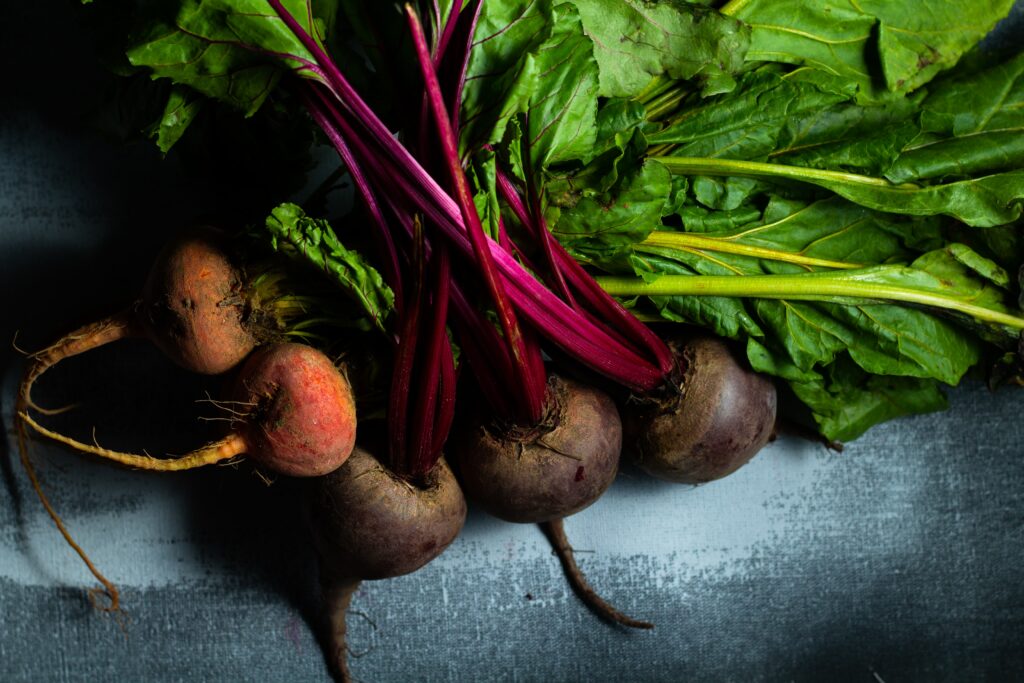| root veg·e·ta·ble | ro͞ot,ro͝ot ˈvejtəbəl,ˈvəjədəbəl/
plural noun: root vegetables (Italian : tuberi)
1. the fleshy enlarged root of a plant used as a vegetable, e.g., a carrot, rutabaga, or beet.

Beet and Goat Cheese Arugula Salad by Giada de Laurentis, (via Food Network)
(Serves: 4)
*Ingredients
- 1/4 cup balsamic vinegar
- 3 tablespoons shallots, thinly sliced
- 1 tablespoon honey
- 1/3 cup extra-virgin olive oil
- Salt and freshly ground black pepper
- 6 medium beets, cooked and quartered
- 6 cups fresh arugula
- 1/2 cup walnuts, toasted, coarsely chopped
- 1/4 cup dried cranberries or dried cherries
- 1/2 avocado, peeled, pitted, and cubed
- 3 ounces soft fresh goat cheese, coarsely crumbled
Directions:
Line a baking sheet with [parchment]. Preheat the oven to 450 degrees F.
Whisk the vinegar, shallots, and honey in a medium bowl to blend. Gradually whisk in the oil. Season the vinaigrette, to taste, with salt and pepper. Toss the beets in a small bowl with enough dressing to coat. Place the beets on the prepared baking sheet and roast until the beets are slightly caramelized, stirring occasionally, about 12 minutes. Set aside and cool.
Toss the arugula, walnuts, and cranberries in a large bowl with enough vinaigrette to coat. Season the salad, to taste, with salt and pepper. Mound the salad atop 4 plates. Arrange the beets around the salad. Sprinkle with the avocado and goat cheese, and serve.

What’s in a beet? Well, I’m glad you asked.
Vitamins A, B6, C, K, Beta Carotene, Calcium, Folate, Iron, Magnesium, Maganese, Potassium, Riboflavin, Thiamin
Just a few (of many) benefits:
- Vitamin A is an antioxidant
- Magnesium is essential for heart health
- Potassium is important for your immune system
- Iron is essential for the oxygenation of your blood
All that and beets are high in fiber, low in fat and have no cholesterol. Yay, beets! I can’t get mine down without copious amounts of goat cheese and walnuts, but still. Yay, beets! Photo credits: 1. Côté Ouest Magazine; 2. Food Network

As always, I recommend using the freshest, purest ingredients available: organic, non-gmo…Please take the time to do your research and support those growers/suppliers/vendors who care about your health and the health of our planet.
You might also like:
Traveling throughout Italy I’ve found that, far from disappearing, the art of preserving is thriving, in homes, in restaurants, and in the agriturismi that have opened in the countryside in recent decades. There are also a growing number of artisan producers throughout Italy whose high-quality goods are helping to fuel the movement. In many cases, young people are leading the way…
Much of the revival has to do with the Slow Food movement, which began in Italy in 1986 in response to the opening of a McDonald’s in Rome’s Piazza di Spagna. The movement, which became an official organization in 1989, now exists in 150 countries and remains especially active in Italy. Among its various programs is the Slow Food Presidia, which supports producers who work to preserve traditional food-processing methods and foods that are at risk of extinction. One of those producers is Sabato Abagnale, who is dedicated to reviving endangered tomatoes and other vegetables grown around Mt. Vesuvius. You’ll meet him within the pages of this book. You’ll also meet Paolo Anselmino and Noemi Lora, who switched careers mid-life to start a small business preserving the foods of their native Alta Langa region in Piedmont. I’ll introduce you to my friend Francesca Di Nisio, who produces organic olive oil and wine in Abruzzo, and other artisans who are doing wonderful things with food. —excerpt from Preserving Italy by Domenica Marchetti
Learn more about the International Slow Food Movement here:







